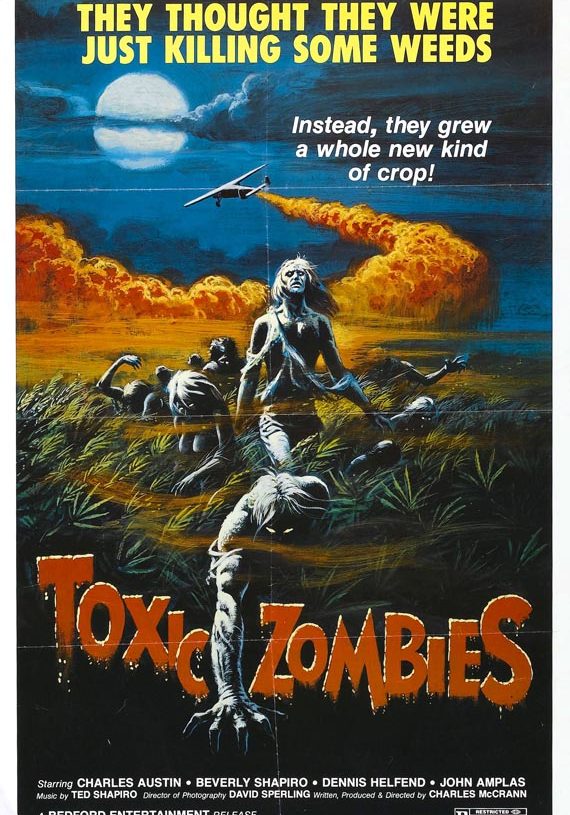A Walk in the Woods Will Never Be the Same: “Toxic Zombies”
As the title “Toxic Zombies” suggests, the movie—released in 1980 and directed by Charles McCrann—plunges its audience into a world where the peaceful setting of nature goes horribly awry. McCrann, who also starred in the film, unfolds a tale of environmental catastrophe meets the living dead. A spoiler-free synopsis reveals that when a band of marijuana-growing hippies encounters a group of corrupt government officials, the officials decide to extinguish the drug menace by applying an experimental herbicide. Unforeseen consequences crop up as the toxic chemical transforms the illegal cultivators into flesh-hungry zombies, unleashing horror upon the unsuspecting countryside.
Bled From Nature’s Wounds: Atmosphere and Tone
The film attempts to sow seeds of horror through an unsettling atmosphere constructed of isolated wilderness, a sense of encroachment, and visuals that shock more by their premise than execution. McCrann’s approach leans into the dread of contamination and the unknown, relying on the viewer’s inherent fears of what could lurk within the sanctity of nature. However, the film struggles to build tension consistently, sometimes veering into camp due to its low-budget constraints.
When it comes to cinematography and visuals, “Toxic Zombies'” use of lighting and camera angles ranges from cleverly claustrophobic to unintentionally comical. The special effects, typical of many B-movies of the era, while earnest in attempt, often fall short of immersiveness due to the limitations of the time. Despite this, one can occasionally glimpse unique flair, particularly in the juxtaposition of idyllic landscapes against the ensuing grotesque horrors.
Soundtrack and sound effects fulfill their task adequately, with moments when the eerie silence of the woods or the sudden screech of an undead attacker effectively punctuates the horror. Admittedly, some soundscapes can be inconsistent, occasionally undermining rather than bolstering the terrifying scenarios.
Through the Rotting Flesh: Characters and Performances
Character development in “Toxic Zombies” is minimal, and the performances range from surprisingly earnest to rigidly stereotypical, often shadowed by the broader narrative. The actors deliver the typical roster of reactions expected in horror but sometimes lack the nuance to evoke a genuine sense of terror.
“Toxic Zombies” dabbles in various horror tropes, predominantly aligning with the body horror subgenre through its depiction of physical mutation and decay. As for its fright tactics, the film leans heavily on gore and the shock of the undead ambush rather than psychological horror, but the execution can be a mixed bag—delivering both blood-chilling and inadvertently amusing moments.
The Haunting Metaphor: Themes and Impact
The movie endeavors, whether intentionally or by happy accident, to pose a critique of governmental overreach and the environmental repercussions of humanity’s tampering with nature. This thematic undercurrent adds a layer of depth to what is otherwise a straightforward zombie narrative, offering a bleak commentary on the era’s eco-political anxieties.
As for its effectiveness, “Toxic Zombies” will not be mistaken for high-brow horror. It may not deliver consistent frights, but its DIY ethos and rawness provide a certain charm that genre purists might appreciate. It’s a specimen of its time, carving out a small plot in the vast field of 80s horror.
Horror aficionados with an affection for the grit and grain of retro B-movies may find merit in “Toxic Zombies”, whereas the casual viewer might struggle to see past its rough edges. Its demographic appeal is niche, catering to those who relish in the historical context and can forgive the technical shortcomings.
Within the horror landscape, “Toxic Zombies” can be compared to other low-budget ventures like “The Toxic Avenger”, though it lacks the deliberate satire of Troma Entertainment’s output. It sits amongst an era ripe with exploratory horror but doesn’t quite reach the cult classic status of its contemporaries.
Final Thoughts: Not Quite an Epidemic
In conclusion, “Toxic Zombies” is a product of its time that embodies the experimentation and unrestrained storytelling of the 80s B-horror wave. Its strengths lie in its unapologetic approach and underlying environmental message, while its flaws are evident in the shaky execution of its horror elements. Those looking for polished scares and high production values should venture elsewhere, but for those curious to dig into the roots of the genre, it could serve as an intriguing, though flawed, specimen.
Consider this a cautious recommendation, with advisories for graphic content, which, while dated, might still unsettle the squeamish. Ultimately, “Toxic Zombies” is an acquired taste, suited for nights of low-expectation indulgence and nostalgic horror treks.




